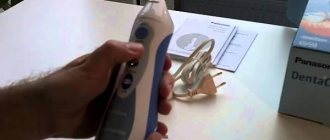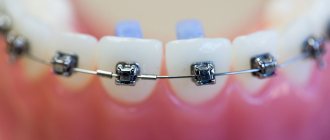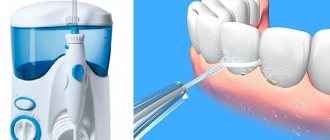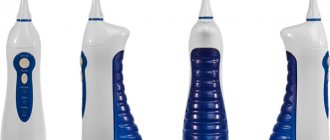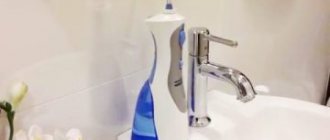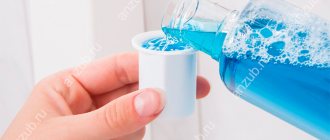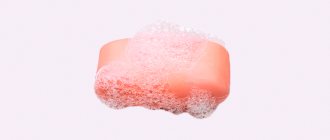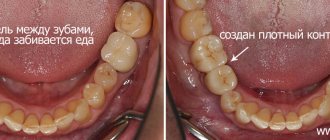An irrigator is a device designed for performing oral hygiene procedures. Its difference from other means is the removal of old plaque and dirt using water under pressure. This item is relevant for patients with braces and other permanent inserts who find it difficult to clean teeth in hard-to-reach places. If you are interested in purchasing an irrigator, you can find a large assortment of these devices at this link.
How to clean the inside of an irrigator
The hygiene product cannot be placed entirely in water, but it must be washed regularly from the inside. Pathogenic bacteria can accumulate in the reservoir, which at some point can penetrate the oral cavity and cause inflammation. Therefore, many device owners must keep the tank clean. In order for the device to serve for a long time and be safe, you need to carefully wash the inner surface with a gentle cleaning agent - soda, chlorhexedine or vinegar. It is necessary to carefully clean and rinse the inside of the tank after cleaning, and also take care of the external surfaces.
Why is it important to care for your irrigator?
In this article
- Why is it important to care for your irrigator?
- How to clean the irrigator from limescale?
- Features of daily care
One of the main elements of the irrigator is a reservoir into which water or a special solution for the oral cavity is poured. Many mineral compounds are dissolved in water; during operation of the device, they settle on its parts in the form of limescale. With prolonged use, hard deposits form on the power unit, pipes, pump and other elements, which we used to call scale. They negatively affect the operation of the device and can lead to breakdowns or complete failure of the irrigator. It is often impossible to repair a device whose parts have accumulated a lot of scale, and it must be disposed of.
If you clean the elements of the irrigator correctly and in a timely manner, this will extend its service life, protect against breakdowns and the cost of purchasing a new device. Therefore, it is important to know how to properly clean the device at home.
Is it possible to clean mold from an irrigator?
It is simply necessary to clean the surface of fungus, since this type of contamination can cause irreparable harm to a person during use. Cleaning can be done using baking soda, peroxide and table vinegar. The advantages of such products are not only their low cost, but also their functionality - they cope well with mold without harming the device. You need to clean the irrigator from the outside and inside - you need to thoroughly wipe the outer surface with a sponge soaked in the substance, then wipe with a brush all hard-to-reach places and joints of elements.
It is imperative to wash the inside of the device, as otherwise mold may enter the human body. It is necessary to make a solution of soda, vinegar, or antiseptic, turn on the device, place the handle in the sink or bathtub and thus rinse the surface several times, first with a cleaning agent, then with water. In some cases, complete disassembly of the device is necessary if mold has completely affected the surface.
How to use an oral irrigator: tips, videos, purpose
The tips collected here will be useful both to those who have already purchased and to those who are just about to choose an oral irrigator. These are our specialists' answers to frequently asked questions from clients. We wrote earlier about how to choose an irrigator.
How does the irrigator work?
An irrigator is a special device for oral hygiene that provides the highest quality care. During operation, water or a special liquid under pressure is supplied from the reservoir. Irrigator nozzles direct water to those areas of the oral cavity that cannot be reached with a toothbrush or floss. There, the water, due to pulsations, cleans the interdental spaces and massages the gums.
The water pressure can be adjusted. All surfaces of the teeth, gums, tongue, interdental space, dentures and orthodontic structures are cleaned.
How often to use a waterpik
Every time after brushing your teeth with a toothbrush. Due to braces and bridges, food debris gets stuck more often, so if you wear braces in your mouth, you should use a waterpik after every meal. Even if you manage to use the irrigator only once a day, it is better than not using it at all. The main thing is to do it regularly and not stop. Then you will receive excellent prevention of gum disease and high-quality cleaning of hard-to-reach areas of the oral cavity.
What to put in the irrigator? Water, balms?
Drinking, bottled water, and saline solutions are suitable for the irrigator. The water should be at room temperature. Hot water harms the irrigator, and cold water damages the teeth. You can also use tap water if it is not too hard. Herbal infusions can cause deposits in the irrigation system, causing it to need to be cleaned more often than usual. Dentists recommend using special balms that can be added to the water before procedures.
- Balms kill pathogenic bacteria.
- Freshen your breath.
- They are carefully filtered, so they do not clog the irrigator with microparticles.
- They do not foam inside the device, unlike mouth rinses.
- They do not leave sediment like herbal infusions.
- They have an anti-inflammatory and healing effect.
Am I holding the waterpik incorrectly?
In order to use an oral irrigator correctly, you must hold it so that the stream is at right angles to the surface of the teeth or gums. Be prepared for a lot of splashing at first, but you'll get better at it over time. There will be a lot of water, so do the procedures at the sink.
How to choose pressure
The irrigator strengthens the gum tissue. But before this happens, you should limit yourself to the weak pressure of its stream. Gradually increase the pressure to the maximum (600-700 kPa), it is with this that you can achieve a therapeutic effect on the gums. There is a common misconception that an irrigator does not properly rinse the space between the teeth unless the pressure is maximized. This is wrong.
Why are attachments needed?
The attachments expand the list of useful properties of the irrigator, clean out gum pockets, and additionally cleanse plaque from tooth enamel. It is recommended to change standard brush heads approximately once every six months, brush heads with bristles or rubber bands - once every 3 months, like a toothbrush.
- Standard. If you do not have any special diseases or structures in your mouth, a standard attachment will suit you. It has no bristles and looks like an angled tube. Thoroughly and effectively removes plaque and food debris. As a rule, most irrigators come with two such attachments.
- Orthodontic. A curved tube with a tuft of bristles at the end. Used for braces and other similar structures. The combination of mechanical action and a jet of water allows you to clean the spaces between the teeth and the arches of braces, and remove plaque in hard-to-reach places.
- Periodontal. Designed for periodontal pockets. The tip of the nozzle is made of soft silicone or rubber, which does not injure sensitive gums. The periodontal nozzle cannot be used at maximum pressure - it already artificially creates additional pressure and with strong pressure its tip may simply fly off.
- Brush attachment for removing plaque. Provides additional care for crowns, bridges and fixed dentures. Does not replace a regular toothbrush.
- For cleaning the tongue. The spoon-shaped attachment is used after brushing your teeth to remove plaque from the surface of the tongue, cheeks and palate.
- Brush attachment. Used as a toothbrush in combination with a stream of water. Cleans teeth, crowns, dentures well. Suitable for daily use. It is important to remember that this attachment will not replace a toothbrush. In addition, her stubble is very hard.
- Nasal attachments. Suitable for cleaning nasal cavities.
Cleaning the WaterPik irrigator
Cleaning the device is somewhat different from washing regular dishes. Since the device is electric, it cannot be completely immersed in liquid. If necessary, you can disassemble the item into parts and wash each part separately. If the contamination is minor, just fill the tank with warm water to the maximum mark, lower the spout into the bathtub or sink and turn on the device, wait until all the water drains out. If the contamination is serious, such as mold or scale, you need to add special cleaning agents and disinfectants, then remember to rinse with clean water.
The best way to refill the device tank
What is the best dentifrice to put in the reservoir? The liquid, first of all, must have a comfortable temperature. To cleanse the oral cavity of plaque and food debris, filtered or distilled water is suitable - it will do the job well and will not damage the parts and “insides” of the device. If you use running water from the tap, then it is better to settle it before use, because the quality may be quite poor, it may contain various impurities, sand particles, debris - all this can become clogged in the device and lead to a malfunction.
If the goal is not only to remove contaminants, but also to have a therapeutic effect on the enamel and gums, then, depending on the problem, you can select a specialized liquid with a hemostatic, strengthening, and antiseptic effect. When choosing a composition, make sure that it is specialized and suitable for your device. But you should not experiment with decoctions of various herbs - if you do not strain the decoction well enough, then particles of herbs and plants may subsequently become clogged inside the device, and not every model can be disassembled and cleaned.
Remember that when using specialized liquids, foam may form, so after hygiene procedures the tank will need to be rinsed with water.
Stages of cleaning an irrigator with vinegar
Vinegar is one of the cheap products that will thoroughly clean the surface of the irrigator without harming it. Despite the fact that this substance smells unpleasant, a strong aroma remains for some time, it is one of the safest substances for humans when used correctly. To clean a contaminated surface, soak a sponge or rag in vinegar and wipe the tank and surfaces clean. When working, you should wear gloves only, protecting your respiratory organs. Vinegar is used to combat fungi that are dangerous to human health. It is necessary to start fighting mold in the irrigator - using such an item is unacceptable, harmful bacteria can enter the oral cavity and cause various diseases. Author of the article: Vsevolod Bobrenkov (stommarket.ru)
Special solutions
It turns out that there are special solutions for removing scale from irrigators. I haven't seen them in pharmacies. But you can come across them in online markets. Sometimes the virtual store service offers a joint purchase of an irrigator and care products. For example, if you decide to buy Panasonic irrigators on the Internet, right there you will receive an offer to purchase liquid to care for it. Convenient and useful! Such liquids are absolutely harmless. However, the device must be thoroughly washed after use.
Caring for the irrigator does not require special skills. Proper care of the device allows you to increase its service life. You just need to follow a number of simple rules. The irrigator requires high-quality purified water to operate. Regular removal of scale from the walls of the device will protect the mechanism from damage. Remember, careful and competent handling of the irrigator will prevent its premature breakdown.
Recommendations for safe and effective use of the device
Cleaning the oral cavity with an irrigator should be carried out according to the instructions for use. We will talk further about how this is done correctly. To begin with, we will give some tips and recommendations to ensure that your first acquaintance with the device and its subsequent use are safe and effective.
General recommendations:
- use the device in comprehensive oral care: that is, not instead of a brush, paste and rinse, but only together with them. Remember that an irrigator is not an independent tool, it does not replace, but only effectively complements all the others,
- Start getting acquainted with the device on the lowest setting: this will help your gums and teeth get used to new unusual sensations and avoid discomfort. As you get used to it, the water pressure can be increased,
- if you have braces, crowns, bridges and dentures, you need to clean not only in the morning and evening, but also after meals,
- You cannot use floss before the irrigator: if you floss carelessly, you can damage your gums, and then subsequent cleaning can aggravate their condition,
- when a stream of water is applied, it is better to keep your tongue raised up: then the liquid will not enter the stomach and lungs, but will pour out,
- if you experience pain, then you need to stop cleaning or adjust a more gentle mode,
- Each family member has their own replaceable nozzle, but there can only be one device,
- the cleaning procedure for children should only be carried out under the supervision of parents: there are “children’s” models suitable for use in children over 3 years old, but doctors do not recommend using the device until the child is at least 6 years old,
- if there is acute inflammation of the mucous membrane or bleeding that does not go away within 3 days, then you must stop using the device until you consult a doctor,
